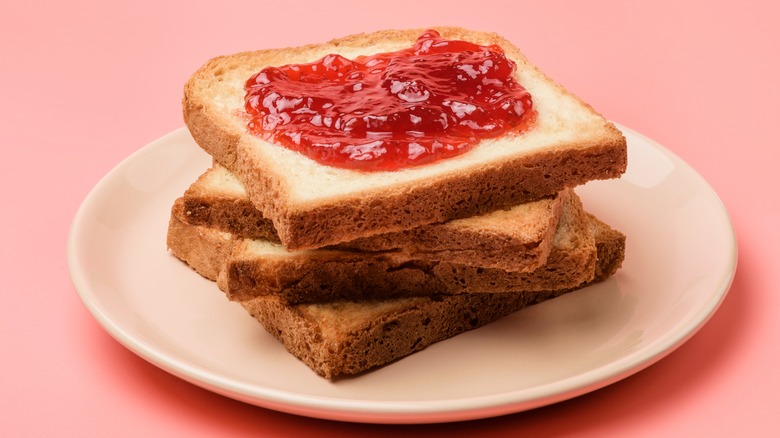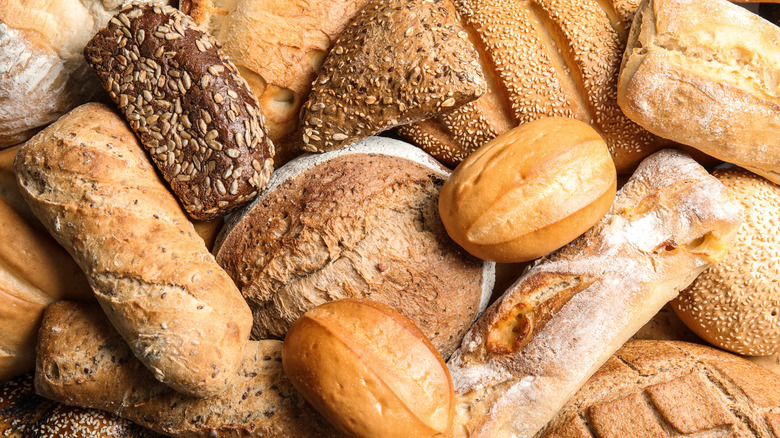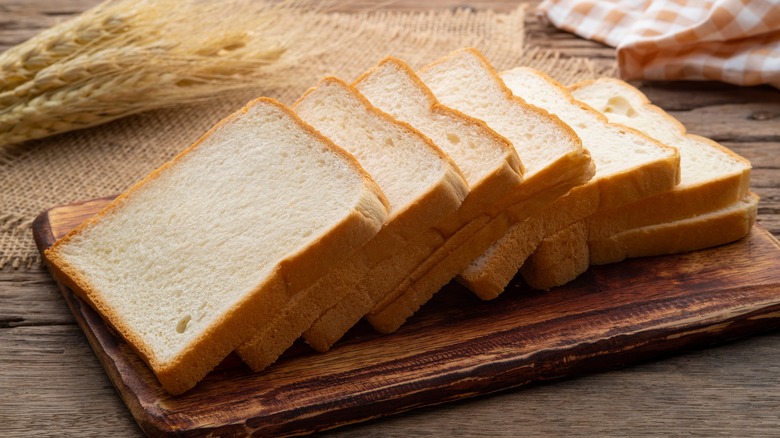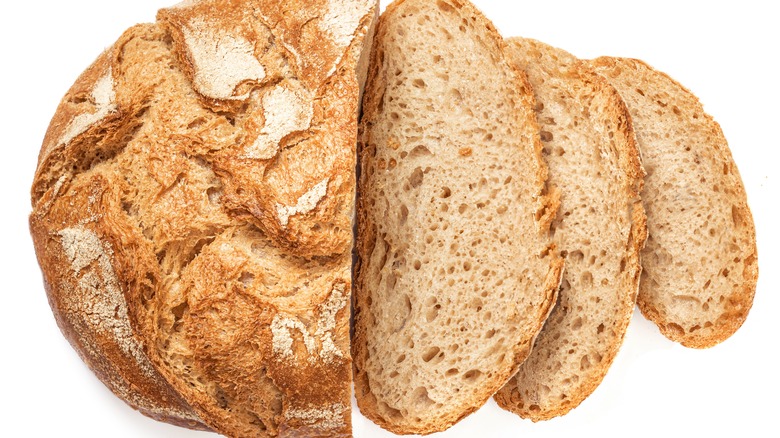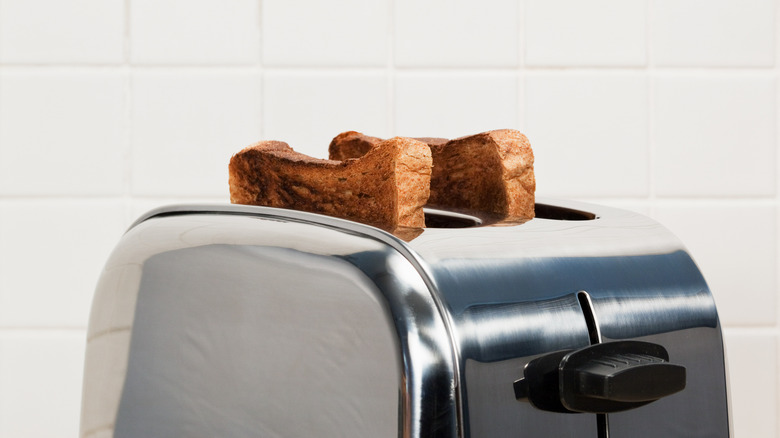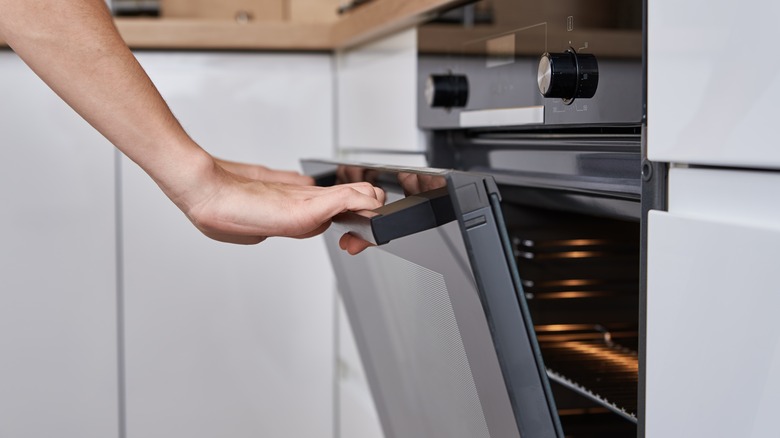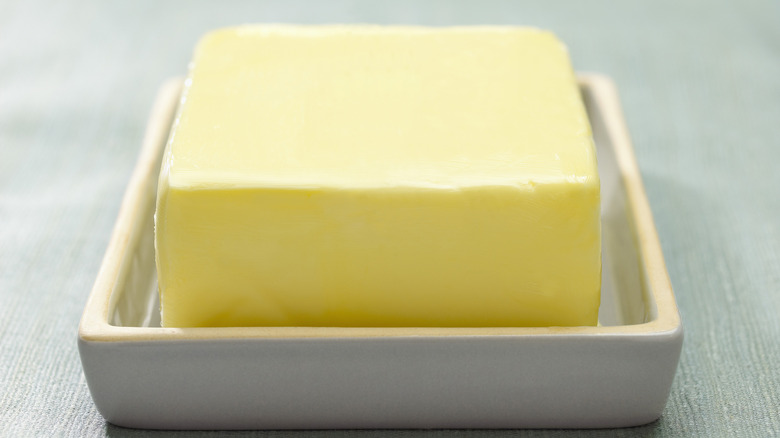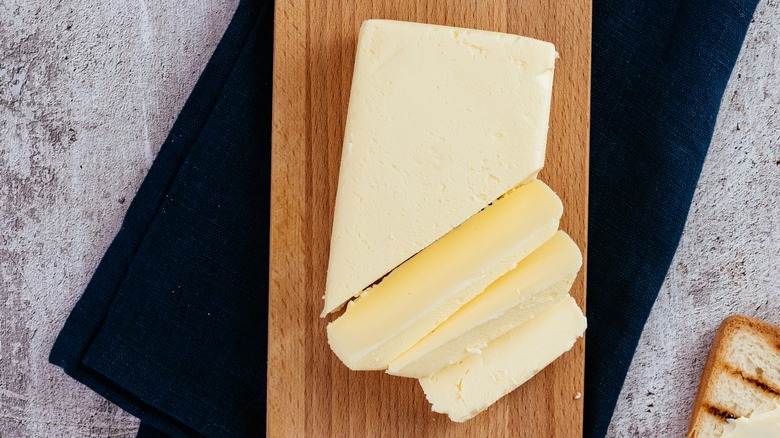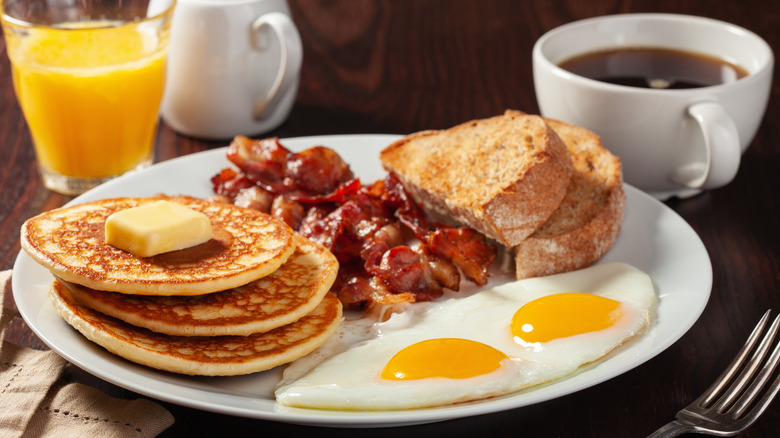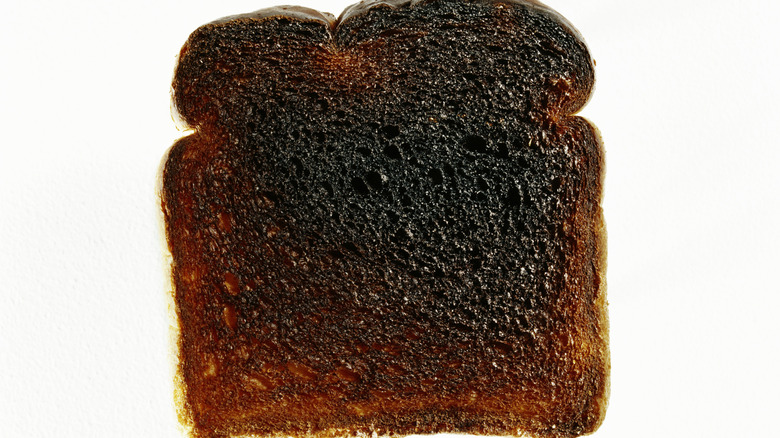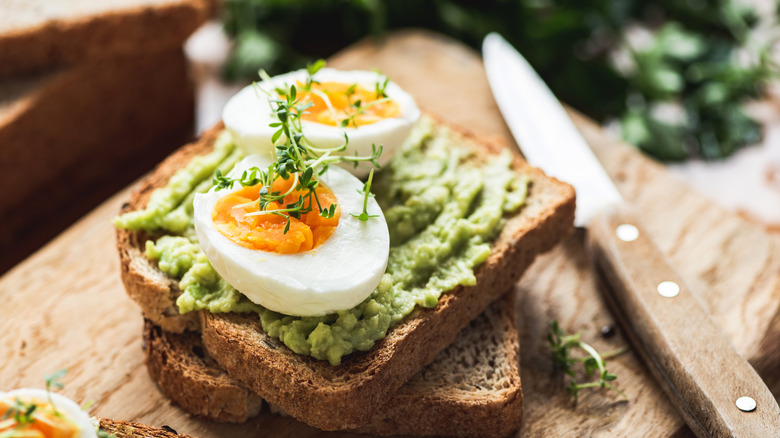11 Tips You Need For Perfectly Crisp Toast
You've heard it for as long as you can remember: Breakfast is the most important meal of the day. And if you've slogged your way through the early hours of work after skipping breakfast, you know exactly why that statement exists (and have you ever downed a few cups of coffee on an empty stomach? That's not a great idea, either).
There are so many options at your disposal when it comes to breakfast food. And yet, in the vast realm of breakfast food, toast is often overlooked. It's tacked onto the side of early morning restaurant visits, it's tossed into a toaster with heating settings that never seem to perform the same. Perhaps it's quickly chowed down while running out the door, as you rush to your car, your watch reminding you just how late you are for the big meeting at work. It's sad, really. A perfectly toasted piece of bread can be exceptionally delicious.
Sure, a piece of toast will almost always be the background singer to your breakfast's main star, but that's okay. It's there when you need it, and it's the delicious addition that can put your meal over the top. It doesn't take long or much prep work for you to prepare exceptionally delicious and crispy toast. In fact, all it takes is for you to follow these steps.
Not all bread is created equal
Maybe you're like most of us and you just fish around for two slices of bread in whatever bag you have at home (of course, if you're also like us, you probably skip over the heel, because that's just all crust, and who wants that as a piece of toast?).
The thing about this is, however, that not all bread is created equal. While you likely have a favorite kind of bread in terms of taste, each bread is going to require different toasting settings. It's why some bread might come out looking decent from your medium-high toaster, and why other kinds of bread come out as if they just popped out of an active volcano. In order to optimize your toast experience, you need to first take into consideration the kind of bread you are using.
Different bread types take different kinds of heat. Whole grain bread can take higher temperatures. Baguettes and ciabattas need a lower temperature. Brioche, which is naturally buttery, requires low heat, otherwise, it'll burn up. Any bread can be used to make toast. You just need to know how to handle it (and how it handles heat). Once you master this step, you'll be well on your way to becoming a toast-making wizard.
Tender inside vs. toasted through
Do you like a perfectly toasted piece of bread, or do you enjoy a tender inside and a crispy outside? There's no wrong answer, but it will impact the kind of bread you should use in order to better reach that level of moisture (or lack thereof) within the toast.
If you're in the former category, and want the toast nice, crispy, and dry, you'll want to consider using day-old deli bread, such as a sliced baguette. Leaving it out overnight will help pull out excess moisture, making it easier to achieve the totally toasted slice of bread (without toasting it longer, which can lead to burning). A little tip we like to do is popping into the local bread shop or grocery store with a bread deli after work. Many locations will sell day-old bread for a discounted price. This is fantastic for toast (or garlic bread), and it's a good way to save some cash, which is a huge plus.
On the flip side, if you like a tender middle but toasted exterior, opt for whole-grain bread (and you can always make some homemade bread yourself). Whole grain naturally has more moisture locked in. Not only does this mean the bread can handle higher heat, but it allows you to toast the exterior while holding onto a chewy middle. Naturally, you'll want to take care, wrap the bread up when you're done using it, and, yes, secure it with the little twisty-tie thing.
Find the optimal thickness for your toast
According to food researcher Dom Lane, notes The Times of India, who actually spent the time to toast (and eat) over 2,000 slices of toast, he found the optimal thickness for a slice of toast is 14 millimeters. Now, for anyone not accustomed to the metric system, this is .55 inches — we'll just call it roughly half an inch. The research indicated this was the optimal thickness that helped maintain some internal softness while reaching a nice, external crunch. If you like more chew and less crunch? Opt for thicker slices. Of course, if you don't like internal softness, you can skip this step. After all, you might already be leaving your bread out the night before to rid it of that moisture.
If you purchase pre-cut bread, you might need to break out the ruler. This is because the average thickness of pre-sliced bread in the United States is anywhere from ⅜ of an inch, up to ⅝ of an inch, adds Golden Medal Bakery. Ideally, you'd want your slice to be ½ an inch. On the other hand, if you buy bread you can cut yourself, this should be a little bit easier. After a few measured cuts, you'll be able to eyeball it on your own.
Toss that old toaster
Okay, so you don't need to scrap it (although we wouldn't fault you if you decided to slide it into the upcoming garage sale you have planned). But don't feel the need to go out and buy a toaster. Yes, we've all been tempted by those outlandish toasters for sale in the kitchen appliance section of the grocery store. We've seen the smart toasters that'll begin cooking toast at designated times, which absolutely sounds like a great time saver in the morning (but then we look at the price tag and decide that no, paying rent sounds better). Toasters just take up too much space on the counter and, in reality, they aren't even the best option for toasting bread. Is it fast? Sure thing. But it's two scalding hot filaments a few millimeters away from the bread, which isn't ideal.
Instead, use your oven. A convection oven can work, but we like the final product of an oven better (especially if you have to cook toast for more folks than just yourself). Adjust the baking rack at the top of the oven. You can use a baking sheet, or you can set the toast right on the rack; it's up to you. This method will take a few minutes longer (so maybe keep your toaster for those rush jobs), but if you're already whipping up bacon or frying eggs, you'll have time.
Watch the toast bake
Preheat the oven to 350 degrees Fahrenheit. Let the bread bake for four to five minutes, then flip once it has turned a nice golden brown. It will likely only take the other side two to three minutes to reach the same golden brown state. If you want more crunch and less chew, crank the oven to 400 degrees Fahrenheit with the same bake time. But, again, remember, low/no moisture bread will bake quicker, so there might be some experimenting on your part, based on the bread you're using. Thicker bread, like Texas Toast, requires a higher temperature of around 425 degrees Fahrenheit.
Once you have the cooking time down to a science, you won't need to hover around the oven, poking your head in to see if the bread is ready or not. In fact, if you have an oven light (and a clean oven window), it's just as easy to check the toast that way, instead of losing heat and affecting the oven temperature every time you open the appliance.
Pick the right butter
Don't just go with any old butter, as it's going to give your toast that delicious, creamy flavor. Unless you are lactose intolerant or don't eat dairy, fake butter simply doesn't have the same kind of fat, and it results in a bland taste to it. There's nothing like the delicious taste of melted butter on a heated-up piece of toast. The way it melts and begins to glide along the toast like a puck on that air hockey table you so desperately wanted as a kid is part of the experience.
It's okay to splurge an extra buck on better-tasting butter. The butter is going to last you, and, unlike other store brands that taste exactly the same as name brands, you absolutely can taste the difference when it comes to the butter you're topping your toast with.
As for us? We loved Horizon Organic and Organic Valley (salted or unsalted, take your pick) when we performed a taste test a while back. These were the two most unanimously enjoyed butter brands. But if you want something with a creamier, more intense flavor, opt for Kerrygold Pure Irish Butter. It does have a brighter color to it, which, if it came off of a no-name brand, we would have assumed it to be artificial (because it's inching dangerously close to that fake mac and cheese powder color), but Kerrygold Pure Irish Butter is, as the name suggests, pure butter, and a great option.
Don't refrigerate your butter
Yes, though there's the old adage, "it's dairy, so it needs to be refrigerated," that isn't exactly the case. If you were to visit most other countries around the world, you would find cartons and bags of milk sitting next to racks of eggs not anywhere near a refrigerated section. In case you're wondering, this is because the United States and Canada both use a pasteurizing method known as high-temperature short-term. This is more efficient and cheaper than the alternative, but it also results in a very short shelf-life. On the other hand, most of the world uses a pasteurization method known as ultra-high temperature, which heats the milk to a significantly higher temperature. It costs a bit more, but the milk will stay fresh for months without the aid of a refrigerator.
Okay, we're back from our brief Bill Nye the Science Guy interruption. As for butter, according to Healthline, salted butter does not need to be kept cold, due to the especially low risk of growing bacteria (but use a butter dish to protect it from dust, hair, and flies). Chances are, you've tried to later a nice piece of toast with butter right out of the fridge before, and chances are you absolutely hated the final result. Now you know, as long as you polish off that butter within a week or two, there's no need to put it in the fridge. After all, warm, non-fridge butter spreads like, well, butter.
Ideally, eat toast for breakfast
Some slightly toasted bread can be a great enhancement to a delicious sandwich. BLTs with lightly toasted bread just hits differently than limp bread out of the bag, and it's called grilled cheese, not floppy white bread cheese, for a reason. So toasting up bread for different meals absolutely does have its time and place. However, the majority of the time, the time and the place should be in the morning for breakfast.
You might be wondering why we would suggest focusing on your toast consumption in the morning. Well, did you know there's a more optimal time of day to eat bread (and carbs in general)? According to the Cleveland Clinic, eating carbs in the morning will give you prolonged energy throughout the day, due to how carbs are broken down and digested. While adding some protein to your toast is a good option if you want prolonged energy throughout the day, carbs are broken down quickly and will give you more readily available energy, which is likely something you need early in the day. On the flip side, eating carbs, such as toast, in the evening can lead to poor sleep and even heartburn at night. Heartburn at night is not a laughing matter. We need our beauty sleep, and nothing destroys that faster than indigestion and heartburn. So we do what we can to avoid it.
Try, try again
So you found yourself engrossed in the morning news, or you had to physically drag your kid out of bed because they didn't listen to you the night before and stayed up all night playing video games. Whatever happened, you return to the kitchen and smoke is billowing up from the bread in the toaster, or you whip open the oven door and are wafted in the face with the stench of burning bread and sad dreams. It's okay. It happens to the best of us — just don't try to scrape off the burnt bits. Not only is that like fingernails on chalkboards, but there's no real saving it. Unless those were your last pieces of bread, try again.
Not convinced? In a recent study, burnt toast contains a compound known as acrylamide. If you consume a high enough amount of acrylamide, it may increase your risk of cancer. So, say no to cancer and dump the burnt toast (so, yeah, you'd need to eat a lot, and we mean a lot, of burned toast on a daily basis for this to happen, but in our judgment, it's better to just not test fate and to instead start-up on some replacement toast).
Eat your toast right away
The toast is sitting right there as you eat your breakfast. Maybe you decide to stop by your parent's house and take them out to Denny's for an early morning breakfast and a hot coffee. Or you are out on a road trip and pulled off at the Cracker Barrel because it's the only spot that's serving a hot breakfast at such an early hour. Whatever you find yourself doing, there's always going to be those two triangle slices of toast, sitting there, absorbing the butter, glazing over as it grows colder and soggier.
The fact of the matter is there is a very small window in which to enjoy your toast. As soon as it's popped out of the oven, there's a timer on it. Eat the toast with your meal, not at the end. Waiting too long results in a cold, hard, bland piece of toast.
Trust us, we fully understand using that sliced piece of toast to help mop up the runny egg yolk or hot sauce that spilled over onto the plate. If it is your plan to use your toast as a cold sponge and nothing more, that's fine. But if you actually want to enjoy the bread and all its butter goodness, you need to eat the toast right away.
Try a different topping
Maybe butter isn't your thing, or maybe dairy in the morning just doesn't sit with your stomach. There are other options than just those single-serving containers of marmalade at the Big Boy. We have plenty of other toast topping suggestions to consider, including hummus, yogurt, cream cheese, or peanut butter (yes, yes, we know about avocado toast. That's a given).
It really comes down to whether you're a sweet or savory person, and how much time you have in the morning to prepare your breakfast. Don't have much time but desperately need some caloric fuel to help power you through until lunch? Opt for peanut butter. Are you still low on time but would rather have something more flavorful? We love good-flavored cream cheese — it doesn't have to just go on bagels. One thing we would recommend, though, is you might want to keep a toothbrush in your office cubicle (or, at the very least, some mouthwash). Because for every action there's a reaction, and the reaction to our love of indulging in garlic and chive cream cheese leads to an atomic bomb of bad breath whenever we talk, and dousing it with coffee sure doesn't help. Thankfully, a few swings of Listerine sure do help.
